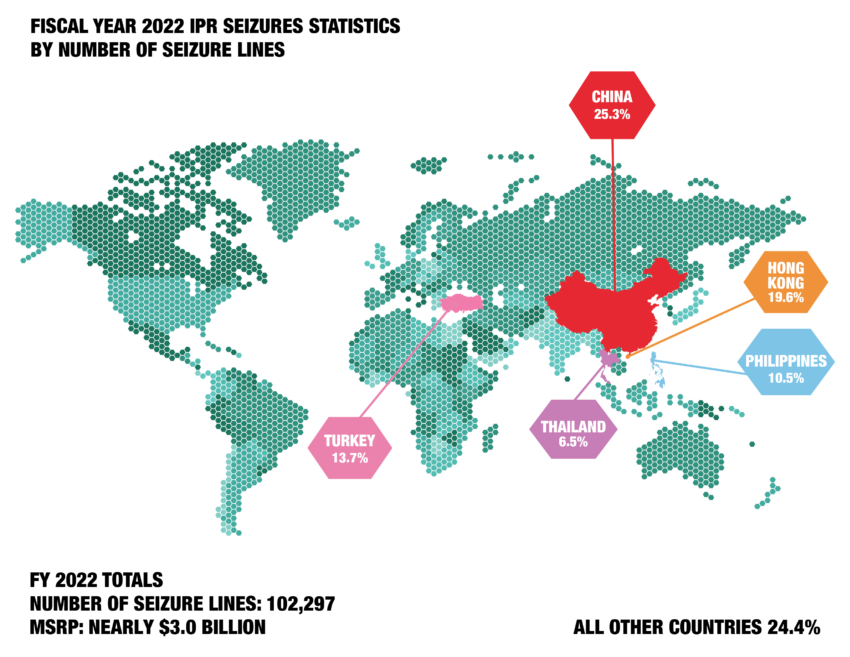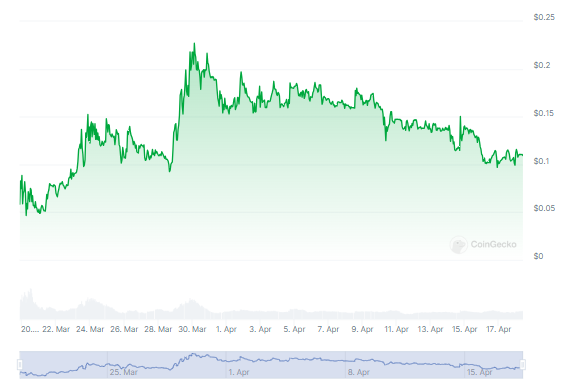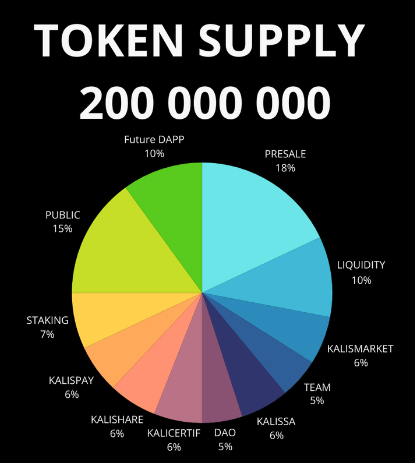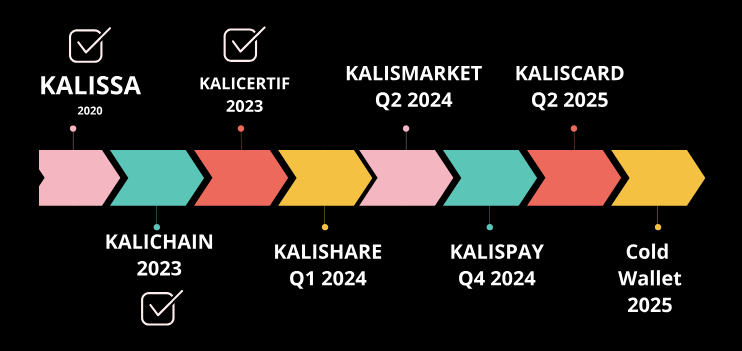Kalichain embodies the “Don’t trust, verify” rallying call in crypto. But what is the real-world-asset (RWA) focused blockchain, and what should you know about it? This guide covers everything from the project’s tokenomics and ecosystem to its underlying technology and investment potential.
What is Kalichain?
Kalichain is a decentralized layer-1 blockchain and ecosystem focused on certification. The blockchain blends Near Field Communication (NFC) technology and non-fungible tokens (NFTs) to verify the authenticity of physical goods.
The proprietary blockchain holds full control over its protected applications. This allows Kalichain to manage users’ access and protect sensitive information. It also ensures the blockchain meets the specific needs of authenticity verification across industries, offering a secure certification solution for brands and consumers.
The Kalichain ecosystem is extensive. It encompasses a (web3) clothing brand, an investment platform focused on tokenization, a payments platform, a global marketplace, a blockchain explorer, and a flagship product certification method, Kalicertif.
Kalicertif uses advanced algorithms and AI to verify products. Every distinct product can be recorded and verified on its blockchain as an NFT. This authenticates a product’s authenticity, regardless of how often ownership is transferred.
Via the NFC function or a QR code on the dedicated mobile app, users can easily scan a product and access metadata about its background, origin, and chain of custody. Here’s why this use case matters.
The problem with counterfeiting for authors and brands
Counterfeiting is the unauthorized replication of branded products. Counterfeiters attempt to mislead consumers and profit from a brand’s reputation for illegal gains. In contrast, fraud is any deceitful activity meant to achieve financial gain. Examples include selling stolen goods or manipulating a product’s history to hyperinflate its perceived value.
For example, counterfeit watches, jewelry, purses, clothing, and shoes are a huge problem in luxury items markets. Suppose someone sells a genuine Rolex watch on a secondary market. If counterfeit versions are also available at a fraction of the cost, they may flood the market, making it difficult for buyers to trust the authenticity of any watch they’re considering.
This is a common occurrence with luxury items. Unfortunately, many buyers unknowingly purchase fake items at the prices of genuine articles. In a way, this is theft by another name.
Impact on secondary markets
Counterfeiting creates major obstacles in several industries. Firstly, it undermines consumer’s confidence and robs creators and brands of their fair share, especially in secondary markets. This has created a pressing need for effective methods to verify product authenticity and guarantee earnings for the originators.

According to U.S. Customs and Border Patrol, there were nearly $3 billion worth of IP (intellectual property) seizures in 2022. This amounted to over 100,000 seizure lines in multiple countries.
When counterfeit items enter these markets, they create an inflated sense of supply. This ultimately devalues the genuine items by saturating the market with fakes. This not only affects the brand’s prestige but also results in financial losses for original creators.
Impact on workers
Businesses suffer financial loss every time you purchase a counterfeit item. Over time, this results in lower earnings and a loss of jobs. Therefore, counterfeiting isn’t just a problem for large corporations; it also affects the everyday worker.
When you purchase counterfeit goods, you not only rob corporations and original creators; you are also taking from the people that they employ and their families. This is why it is important to verify the source of your purchases.
How does Kalicertif work?
Kalicertif acts as a solution to the problems outlined above. Each product within the Kalichain ecosystem is linked to an NFT that acts as a digital certificate of authenticity. Kalichain stores this NFT on the blockchain. This makes the products virtually impervious to forgery or duplication.
The Kalichain mobile app is used to verify the product’s QR code or NFC chip. NFC allows the wireless transfer of data over short distances. This is typically between a mobile device and a small chip embedded in a product or tag, allowing multiple devices to scan a product and receive information. The app then accesses the blockchain to retrieve the product’s NFT, displaying comprehensive data regarding the product’s origin, history, and manufacture.
This system makes it extremely challenging for counterfeiters to replicate the authenticity of a product because they cannot duplicate the unique NFT associated with it. Additionally, it combats fraud by recording each transfer of ownership on the blockchain, making it virtually impossible for fraudulent sellers to tamper with a product’s history. If someone steals an item, its chain of custody also aids in its recovery and identifies it as stolen.
How Kalicertif generates creator revenue
The remuneration function for authors is based on the use of blockchain technology and NFTs (digital certificates), as well as secure NFC chips. Kalicertif’s remuneration function distinguishes the work’s author from its owner.
The author, as the guarantor of the work, plays a crucial role in every sales transaction, as they must transfer a digital document of traceability and certification, called a “carte grise,” with each change of ownership. This “carte grise” is sold by the author, allowing them to earn revenue with each work transaction on the secondary market.
This model generates continuous revenue for artists through successive resales of their works and also certifies the authenticity of products in general, thus reducing counterfeiting.
How to use Kalicertif to protect your products

1. Kalicertif’s certification methods
Kalicertif offers two primary methods for product certification based on the item’s value:
- A secure, encrypted NFC chip for high-value items like artworks or luxury goods,
- For less expensive items, a simpler QR code is sufficient.
2. Registering the product on Kalicertif
- The company or individual owning the product logs into the Kalichain platform.
- They enter all relevant details about the product to be certified. This includes description, origin, manufacturing date, etc.
- They then use these details to create a unique NFT for the product on the blockchain.
- Once you create the NFT, Kalichain generates a corresponding QR code or an NFC chip ID for the item.
3. Marking the product
The product is physically marked with the QR code or NFC chip, depending on the chosen certification method. QR codes are for less valuable items, while NFC chips are for more valuable. The identifier’s placement can vary: it might be on the product’s label, packaging, or directly on the item.
4. Activating the certification
Kalicertif has now officially certified the product. Each time the QR code or NFC chip is scanned using Kalichain’s mobile app, it pulls the item’s information from the blockchain. The app displays all verified information retrieved from the NFT, confirming the product’s authenticity.
If the chip is physically removed, digitally altered, or attempted to be copied, the associated NFT is immediately destroyed, generating a message indicating that the product has been corrupted. Everything is on-chain and verifiable.
Kalichain (KALIS) tokenomics
Kalichain’s utility crypto, KALIS, offers unique advantages and tokenomics. It streamlines transactions within the ecosystem, enabling users to reap rewards and participate in special promotions.
KALIS launched on March 19, 2024. As of April 18, 2024, the coin is sitting around 50% below its all-time high, recorded on March 29, 2024.

The total supply of KALIS is 200 million. This finite supply aims to add value to each coin, with 75% of the total supply intended to be sold during the distribution phase. The allocation of the total supply is broken down as follows:
- Presale: 18%
- Liquidity: 10%
- Future DApp (decentralized application) development: 10%
- Public sale: 15%
- Staking: 7%
- Kalismarket: 6%
- Team: 5%
- Kalissa project: 6%
- DAO (decentralized autonomous organization): 5%
- Kalicertif: 6%
- Kalipay: 6%
- Kalishare: 6%

Within the Kalichain ecosystem, companies or product owners use KALIS coins to pay for various services. The value of Kalis is closely linked to the growth and success of the Kalichain ecosystem. As a result, as the ecosystem expands and the number of transactions increases, the demand for KALIS could grow.
Note that KALIS can be purchased exclusively on MEXC.
Governance
Nodes play a pivotal role in Kalichain, not just in maintaining the ledger but also in securing the overall ecosystem. These 39 decentralized nodes ensure the security and resilience of the network.
Kalichain encourages user ownership of nodes, which supports the network’s functionality and also grants users a stake in its future. Node owners are rewarded for their contribution to the maintenance and operation of the network.
Governance within Kalichain is a community-centric process, allowing all members to propose and vote on the network’s evolution. This ensures that changes and developments within Kalichain are reflective of the community’s consensus and aligned with the collective vision.
Kalichain’s governance is set to become even more democratic, with plans to include a decentralized autonomous organization (DAO). This DAO aims to further decentralize the platform’s governance by putting decision-making authority in the hands of users.
Kalichain ecosystem
Kalichain is more than just a blockchain; it’s a complete ecosystem with various applications that fulfill distinct roles. Here are a few products that Kalichain has to offer outside of authentication.
Kalissa

Kalissa is a fashion brand under the Kalichain umbrella. It serves as a real-world proof of concept of the practical application of blockchain in verifying authenticity. In this way, Kalichain goes beyond mere theory. Kalissa’s verified and high-quality offerings highlight the technology’s capabilities.
Kalissa is a luxury clothing brand brought to you by Kalichain. Each piece of clothing has a unique NFT on the Kalichain blockchain, which contains detailed information about the item, including its manufacture date, provenance, and authenticity.
Kalishare

Kalishare is another of Kalichain’s flagship projects. It uses tokenization to change how we invest in real estate, products, and businesses, leveraging blockchain technology to make investing in real assets more transparent, secure, and accessible to people everywhere.
On this platform, users can rent cars and apartments, demonstrating how blockchain can handle real-world assets and transactions efficiently.
To be an investor, you must hold KALIS. Moreover, if you own a product verified by KALISSA, you can invest in Kalishare.
Kalicertif
Kalicertif sits at the core of the Kalichain ecosystem. It provides a vital service for authenticating products and documents. Using blockchain and NFT technology, Kalicertif creates a digital certification, ensuring that items are genuine for businesses and consumers.
This application plays a crucial role in fighting against counterfeiting and guarantees that original creators and brands are fairly compensated in the resale market. It is essentially a user-friendly interface for individuals to interact with blockchain-verified products.
Kalispay
Kalipay is another important feature of Kalichain’s long-term financial ecosystem. It will serve as a versatile payment system that supports transactions with certified products. Kalispay will also accommodate various cryptocurrencies, giving users flexibility in how they pay and allowing sellers to accept the digital currency they prefer.
Beyond mere transactions, Kalipay also functions as a financial intermediary, bridging the gap between cryptocurrencies and fiat money. In other words, it is a fiat on-ramp that will allow a smooth bridge for users into blockchain payments.
Kalismarket
Kalismarket is an international platform that allows people to purchase and sell goods without boundaries. With the power of blockchain technology at its foundation, Kalismarket provides a safe and transparent platform for online shopping.
But Kalismarket is more than just a place to shop; it’s a trusted environment where every item is verified for authenticity, ensuring that each transaction is secure and customers can shop confidently.
Kalichain roadmap

From Q2 2024 to 2025, Kalichain’s roadmap indicates several key developments:
- In Q2 2024, the launch of Kalismarket, a global marketplace utilizing blockchain for secure and transparent online shopping, aims to minimize fees and eliminate geographical constraints.
- By Q4 2024, Kalispay will roll out, solidifying the payment system within the Kalichain ecosystem.
- Lastly, in 2025, a cold wallet is slated for release, providing a secure option for storing cryptocurrencies.
Is Kalichain (KALIS) a good investment for you?
Kalichain is fulfilling an important niche within finance and consumer markets. Authenticity and certification underpin most of our activities in the traditional world in some capacity. Kalichain is thus one of the projects leading the way in bridging TradFi and web3, bringing real-world use cases on-chain.
It is important to remember that any financial activity carries some amount of risk, and cryptocurrency is often volatile. Investors should never risk more capital than they can comfortably afford to lose.
Frequently asked questions
Kalicertif is a platform that uses blockchain technology to authenticate and certify documents and objects. It enables the generation of irrefutable digital proof of the legitimacy of your assets. Kalichain sits at the heart of Kalichain’s certification system.
Kalicertif certification consists of multiple steps. Firstly, you define the item or document to be certified. Then you connect it to the platform, and it creates a secure digital record that can be readily shared and confirmed.
No, prior knowledge of blockchain is not required. The platform is intended to be accessible and simple to use for everyone. Additionally, their are instructions and customer support to help you at every stage.
Yes, because the blockchain is transparent and decentralized, the Kalicertif certification is accepted around the world. This makes it possible for validity to be verified internationally.
Kalicertif may certify a large number of items and documents. To learn about the specific items navigate to Kalicertif for inquiry.
Kalicertif employs blockchain technology, which provides optimal security via an advanced cryptographic method. In addition, the platform follows strong security standards to secure personal information and transactions.
All you have to do is register for an account on Kalicertif to get started. Follow the certification process in its entirety. After this, you can start protecting the legitimacy of your assets right now.
Due to their ease of scanning and integration, QR codes are frequently used for papers or products that need to be traceable. NFC chips, on the other hand, are meant to be utilized with expensive items. A higher level of security is provided by the NFC chip, which is perfect for guaranteeing the authenticity and safeguarding expensive items because it is tamper-proof and encrypted.
You can buy Kalichain (KALIS) on MEXC crypto exchange. Remember, cryptocurrency investments are inherently risky, so do your research before you invest.
Disclaimer
In line with the Trust Project guidelines, the educational content on this website is offered in good faith and for general information purposes only. BeInCrypto prioritizes providing high-quality information, taking the time to research and create informative content for readers. While partners may reward the company with commissions for placements in articles, these commissions do not influence the unbiased, honest, and helpful content creation process. Any action taken by the reader based on this information is strictly at their own risk. Please note that our Terms and Conditions, Privacy Policy, and Disclaimers have been updated.




